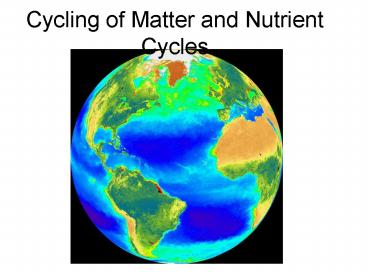Cycling of Matter and Nutrient Cycles - PowerPoint PPT Presentation
1 / 15
Title:
Cycling of Matter and Nutrient Cycles
Description:
Cycling of Matter and Nutrient Cycles The Biosphere Biosphere is the living surface of earth Lithosphere is the hard part of the earths surface Hydrosphere is the ... – PowerPoint PPT presentation
Number of Views:96
Avg rating:3.0/5.0
Title: Cycling of Matter and Nutrient Cycles
1
Cycling of Matter and Nutrient Cycles
2
The Biosphere
- Biosphere is the living surface of earth
- Lithosphere is the hard part of the earths
surface - Hydrosphere is the surface covered in water, both
salt and fresh - Atmosphere is the layer of air above the surface
3
Water Cycle
4
Carbon Cycle
5
Carbon Cycle
- Air contains carbon in the form of CO2
- Plants use light to make sugars which contain
carbon - Organisms break down sugar molecules for energy
and release carbon as waste - Burning fossil fuels and woods release CO2
- Organisms die and their carbon containing bodies
decompose by bacteria and fungi and other
decomposers. CO2 is released. - Under certain conditions the remains of some dead
organisms may gradually change into fossil fuels,
gas, crude oil, coal (all rich in carbon)
6
Nitrogen Cycle
7
Key Ideas
- Earths atmosphere is 78 nitrogen (N2)
- Most organisms cannot use nitrogen in this format
so it must be converted (fixated) - Terrestrial Fixation
- The soil contains bacteria that convert nitrogen
to ammonium (NH4). Other soil bacteria take this
ammonia and convert it into nitrate where plants
can then absorb it. Nitrogen is passed through
the food chain from this point. - Aquatic Fixation
- Cyanobacteria convert nitrogen into ammonium
which is absorbed by plants.
8
- Fixation by Lightning
- High electricity converts atmospheric nitrogen
into nitrates (NO3) - Humans convert nitrogen into ammonium and
nitrates with high pressure and temperature to
manufacture fertilizers - Different bacteria in land and water also can
convert nitrates back to nitrogen to be released
into the atmosphere. - In sustainable ecosystems excess nitrogen is
stored in rocks (lithosphere)
9
Nitrogen Cycle
- Use your text book to complete the worksheet in
your package. Pg. 16
10
Phosphorous Cycle
11
Phosporous Cycle
- Use textbook to fill in Cycle in your package.
Pg. 17
12
Human Activities and Nutrient Cycle effects
13
(No Transcript)
14
Fertilizers and the Phosphorus Cycle
- Run off from fertilizers cause algal blooms
blocks light for submerged plants, algae and
other plants eventually die off, bacteria use
oxygen during decomposition so oxygen levels get
too low for fish to survive so they die off. - Eutrophication A process in which nutrient
levels in aquatic ecosystems increase leading to
an increase in the populations of primary
producers (algae)
15
Homework
- Pg 9, 1-4
- Pg 19 5-8
- Pg 20 1-8































